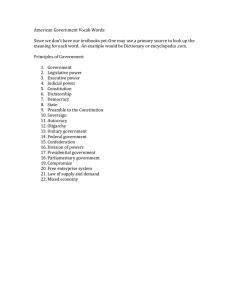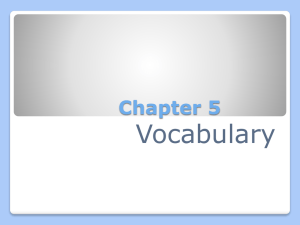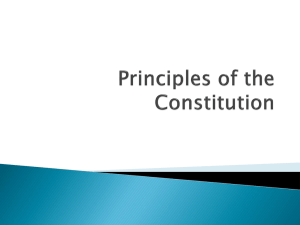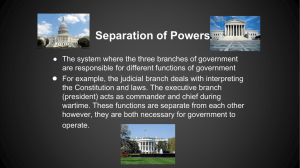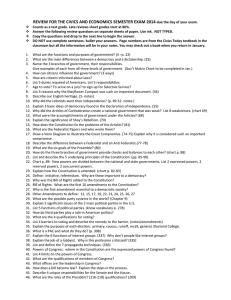Civics Benchmarks Mastered in the fourth 9 weeks
advertisement
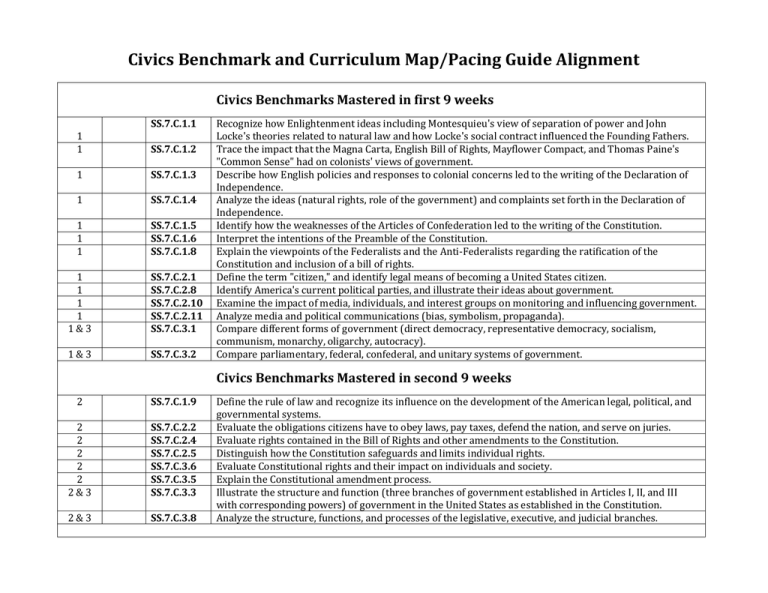
Civics Benchmark and Curriculum Map/Pacing Guide Alignment Civics Benchmarks Mastered in first 9 weeks 1 1 SS.7.C.1.1 SS.7.C.1.2 1 SS.7.C.1.3 1 SS.7.C.1.4 1 1 1 SS.7.C.1.5 SS.7.C.1.6 SS.7.C.1.8 1 1 1 1 1&3 SS.7.C.2.1 SS.7.C.2.8 SS.7.C.2.10 SS.7.C.2.11 SS.7.C.3.1 1&3 SS.7.C.3.2 Recognize how Enlightenment ideas including Montesquieu's view of separation of power and John Locke's theories related to natural law and how Locke's social contract influenced the Founding Fathers. Trace the impact that the Magna Carta, English Bill of Rights, Mayflower Compact, and Thomas Paine's "Common Sense" had on colonists' views of government. Describe how English policies and responses to colonial concerns led to the writing of the Declaration of Independence. Analyze the ideas (natural rights, role of the government) and complaints set forth in the Declaration of Independence. Identify how the weaknesses of the Articles of Confederation led to the writing of the Constitution. Interpret the intentions of the Preamble of the Constitution. Explain the viewpoints of the Federalists and the Anti-Federalists regarding the ratification of the Constitution and inclusion of a bill of rights. Define the term "citizen," and identify legal means of becoming a United States citizen. Identify America's current political parties, and illustrate their ideas about government. Examine the impact of media, individuals, and interest groups on monitoring and influencing government. Analyze media and political communications (bias, symbolism, propaganda). Compare different forms of government (direct democracy, representative democracy, socialism, communism, monarchy, oligarchy, autocracy). Compare parliamentary, federal, confederal, and unitary systems of government. Civics Benchmarks Mastered in second 9 weeks 2 SS.7.C.1.9 2 2 2 2 2 2&3 SS.7.C.2.2 SS.7.C.2.4 SS.7.C.2.5 SS.7.C.3.6 SS.7.C.3.5 SS.7.C.3.3 2&3 SS.7.C.3.8 Define the rule of law and recognize its influence on the development of the American legal, political, and governmental systems. Evaluate the obligations citizens have to obey laws, pay taxes, defend the nation, and serve on juries. Evaluate rights contained in the Bill of Rights and other amendments to the Constitution. Distinguish how the Constitution safeguards and limits individual rights. Evaluate Constitutional rights and their impact on individuals and society. Explain the Constitutional amendment process. Illustrate the structure and function (three branches of government established in Articles I, II, and III with corresponding powers) of government in the United States as established in the Constitution. Analyze the structure, functions, and processes of the legislative, executive, and judicial branches. Civics Benchmarks Mastered in third 9 weeks 3 SS.7.C.1.7 3 3 SS.7.C.3.10 SS.7.C.3.7 3 SS.7.C.3.12 3 SS.7.C.2.9 3 3 SS.7.C.4.1 SS.7.C.4.2 3 3 3 3 3 1&3 SS.7.C.4.3 SS.7.C.3.4 SS.7.C.3.11 SS.7.C.3.13 SS.7.C.3.14 SS.7.C.3.1 1&3 2&3 SS.7.C.3.2 SS.7.C.3.3 2&3 3&4 SS.7.C.3.8 SS.7.C.2.12 3&4 SS.7.C.2.13 Describe how the Constitution limits the powers of government through separation of powers and checks and balances. Identify sources and types (civil, criminal, constitutional, military) of law. Analyze the impact of the 13th, 14th, 15th, 19th, 24th, and 26th amendments on participation of minority groups in the American political process. Analyze the significance and outcomes of landmark Supreme Court cases including, but not limited to, Marbury v. Madison, Plessy v. Ferguson, Brown v. Board of Education, Gideon v. Wainwright, Miranda v. Arizona, in re Gault, Tinker v. Des Moines, Hazelwood v. Kuhlmier, United States v. Nixon, and Bush v. Gore. Evaluate candidates for political office by analyzing their qualifications, experience, issue-based platforms, debates, and political ads. Differentiate concepts related to United States domestic and foreign policy. Recognize government and citizen participation in international organizations. Examples are United Nations, NATO, Peace Corps, World Health Organization, World Trade Organization, International Court of Justice. Describe examples of how the United States has dealt with international conflicts. Identify the relationship and division of powers between the federal government and state governments. Diagram the levels, functions, and powers of courts at the state and federal levels. Compare the constitutions of the United States and Florida. Differentiate between local, state, and federal governments' obligations and services. Compare different forms of government (direct democracy, representative democracy, socialism, communism, monarchy, oligarchy, autocracy). Compare parliamentary, federal, confederal, and unitary systems of government. Illustrate the structure and function (three branches of government established in Articles I, II, and III with corresponding powers) of government in the United States as established in the Constitution. Analyze the structure, functions, and processes of the legislative, executive, and judicial branches. Develop a plan to resolve a state or local problem by researching public policy alternatives, identifying appropriate government agencies to address the issue, and determining a course of action. Examine multiple perspectives on public and current issues. Civics Benchmarks Mastered in the fourth 9 weeks 3&4 SS.7.C.2.12 3&4 SS.7.C.2.13 Develop a plan to resolve a state or local problem by researching public policy alternatives, identifying appropriate government agencies to address the issue, and determining a course of action. Examine multiple perspectives on public and current issues.

